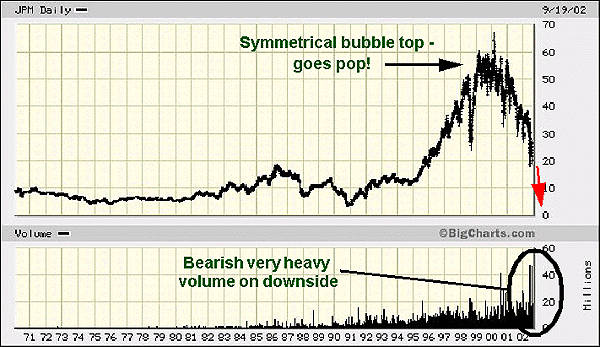JP Morgan Chase & Co.
A Nightmare on Wall Street
Any reader who has an interest in seeing gold go up is likely to enjoy reading this article. To put what I am about to write in an overall context I would like to draw readers' attention to my article "The Great Crash of 2002" which appeared in July in 321gold and Prudent Bear and a number of other sites. Here is an excerpt: "I state now, without exaggeration, that I firmly believe that we are now about to witness, within the next few months, possibly within the next few weeks, the MOST DRAMATIC STOCK MARKET CRASH IN HISTORY, which will make the crash of '29 look like a Sunday School outing." It is within this context that we are seeing the stock of the New York bank JP Morgan, the second largest bank in America, plunging.
There has been a lot of talk circulating these past months to the effect that JP Morgan is a leading member of a cartel holding huge net short positions in gold derivatives and who therefore have a vested interest in holding down the gold price and, in collusion with central banks, who are fighting to defend the fiat money system, dump gold on the market whenever it looks like it will break through a key chart point. In fact, the Office of the Comptroller of the Currency lists JP Morgan Chase as the largest holder of gold derivatives. The reason that they got themselves into this position is historical. They were involved in forward selling gold, which they regarded as a non-performing asset, throughout the 90's to extract value before the price fell further. Elaborate schemes were hatched to free up the value locked up in this "dead asset", which they regarded as mouldering uselessly in underground vaults while other assets were soaring. From what I have heard there has also been some very convoluted and strange accounting employed to tap the value of the yellow metal. The end result of all this scheming would appear to be huge net short positions in gold / gold derivatives built up by banks such as JP Morgan and also plundered bank vaults. Furthermore, a vicious circle has developed in recent times, due to the developing bull market in gold, which is forcing banks to dump their dwindling supplies of bullion on the market at critical points in an attempt to save themselves from being buried by their huge short positions, even though they know they are selling a rising asset. Of course, if JP Morgan is net short gold derivatives in a big way and gold goes up a lot, they are going to be facing a rather large bill, to put it mildly, and that's just one of their major problems.

My first thought when I looked at the long-term chart for JP Morgan was "How could anybody in their right mind buy a stock with a chart like this?" I think the buyers, short term traders aside, must either be fresh out of college, drunk, spending other people's money, or, more likely, a combination of the three. The long-term chart is horrific. With the overall market looking awful, ripe for a crash, I see no other direction for this stock than down. Ordinarily one would expect this stock to find support in the mid-teens, sufficient to halt the decline, but I believe it will plough on down into single figures for the following reasons; the first and most important reason is that the overall market is, I believe, about to go into all-out crash mode and if that happens this will be savaged. The next big reason is that the bond market bubble is getting ever closer to popping, which will result in gargantuan and well-deserved losses for a lot of lenders. I'll give you an example of the crass stupidity of lenders; the housing market bubble in the US is topping out and is about to deflate. Even now householders are being permitted to borrow against the full paper value of their homes and, with an imaginative revaluation of the property, MORE THAN the paper value of their homes. In common with US business generally, the US consumer is spent out and fully loaded with debt - so what happens when unemployment increases sharply, house prices fall and foreign investors dump all US securities including bonds, the dollar crashes and interest rates have to rise? I'll tell you - the average householder will turn round and say "Can't pay - won't pay!" and the lender's only recourse will be to kick the families out of their houses (trying to dodge bullets as they do so) and then try to sell the property in a collapsing property market, either that, or swallow hard and accept that the debt will probably never be repaid. This is JUST ONE EXAMPLE of a default scenario among countless others. The whole system is awash with credit - DEBTS THAT CAN NEVER BE AND WILL NEVER BE REPAID. In other words, bond holders will be left holding one gigantic bag - stuffed full of worthless piles of paper!
Now I now that banks like JP Morgan won't be the only ones left holding the bag, because they have been crafty enough to farm out a lot of this now rapidly souring debt to other unsuspecting takers, such as hedge funds, insurance companies, pension funds, institutional investors and mutual funds through syndication. This syndication of loans has enabled the banks to ramp up their lending activities, since less of their own capital was on the line per deal. Lending standards have also deteriorated with leveraged and sub-standard loans making up an ever-greater percentage of syndicated loans. But, my point is that they are all going to get clobbered.
Another massive problem facing JP Morgan is that they have, by some estimates, more than $20 trillion of derivatives on their books. Yes, that's TRILLION not BILLION. I don't know about you, but I can't even imagine a sum of money so vast, and, you know, I think that might be at the root of the problem. I don't think the management at JP Morgan could comprehend it either, it's so vast it's almost meaningless. "You'd like another $150 billion in dollar call spreads? Consider it done, Mr Rodriguez - shall I book that to Burkina Faso Leveraged Investments Ltd as usual?"
Compared to the gigantic derivative exposure, the $12 billion of loans to cable and telecom companies seems trifling. Given that, with respect to derivatives, about 2% of a bank's total exposure is viewed as being at risk, this means that JP Morgan is potentially liable to the tune of $400 billion, which is considerably larger than the bank's stock market capitalisation of $37 billion.
Yet another problem facing JP Morgan is that, as I understand it, they are facing a not inconsiderable amount of litigation.
Now let's turn to a technical appraisal of the chart for JP Morgan's stock. As I said above, the long-term chart is a horror trip. Take a look now at this long-term chart, shown above. Here we can see how the price ramped up in the mid-late 90's, to reach a bubble top, where smart money had a year or two to unload. It has since been falling at about the same rate as it went up. The whole thing is a remarkably symmetrical cone shape. Note the very heavy volume on the decline this year, record volume, which is a most bearish indication. This suggests to me that the trading range of the 1980's is unlikely to provide much relief or support.

Looking now at the shorter term one year chart we can see, firstly, the steadily downtrending 200-day moving average, which has throughout the year provided a clear and unequivocal warning that this stock should have been sold on rallies, the decline in January and February on heavy volume providing a further warning. There is an interesting example of a selling climax in late July, the deeply oversold condition being signalled by a week of exceptional volatility on huge volume, coupled with a yawning gap between the price and the 200-day moving average. At first glance it is tempting to compare the trading of recent days with that in late July, but there are some important differences. First of all, volatility is nowhere near as great, and volume, although very heavy on a couple of days is, in aggregate, significantly less. Certainly, it is oversold, but I don't think that this will save it this time round, mainly because the outlook for the market as a whole is so bad over the short and medium term. The best that can be hoped for is a trading range or a weak rally for a few weeks at most to alleviate the oversold condition. On Friday 20th the September 20 strike put contract expired worthless with an open interest equivalent to almost 2 million shares of JP Morgan. Of course, we realize that it was just a coincidence that the price of the stock closed a shade above $20 on Friday.
JP Morgan Chase is such a large institution and so important that I really don't know how other banks, the financial community as a whole and the government will react as it plunges deeper into the abyss. At some point an effort may be made to bail it out, but it seems to me that that effort would cost far more than the bank is worth. I reserve my deepest sympathy for those ordinary, hard working employees (and their families) at JPM Chase who played no part in tunnelling under their own company and were probably oblivious to what was going on at higher levels.
To conclude, I consider this stock to be a very bad risk. In the months ahead of us I expect the price to continue to fall into single figures. The outlook for this organisation is grim and some very difficult decisions are going to have to be faced.
JP Morgan Ltd., code JPM (NYSE)
closing price: $20.18 approx. on 20 September 2002
Clive Maund
[email protected]
Kaufbeuren, Germany, 23 September 2002
By Clive Maund, Diploma Technical Analysis, no responsibility can be accepted for losses that may result as a consequence of trading on the basis of this analysis.

















